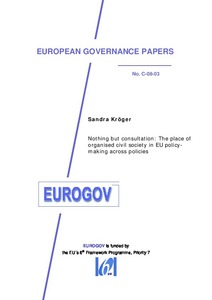Nothing but consultation: the place of organised civil society in EU policy-making across policies
"This article aims to provide a better understanding as to why different institutional arrangements have the particular structural properties which they are found to have. Drawing on the system theoretical tradition in sociology and on ‘complexity theory’, this paper presents an analytical fram...
| Main Authors: | , |
|---|---|
| Institution: | ETUI-European Trade Union Institute |
| Format: | TEXT |
| Language: | English |
| Published: |
Vienna
2008
Eurogov |
| Subjects: | |
| Online Access: | https://www.labourline.org/KENTIKA-19291203124910194859-Nothing-but-consultation-the-p.htm |
| Summary: | "This article aims to provide a better understanding as to why different institutional arrangements have the particular structural properties which they are found to have. Drawing on the system theoretical tradition in sociology and on ‘complexity theory’, this paper presents an analytical framework whose underpinnings are in the idea that the structural characteristics of institutions and organisations are functionally related to the informational complexity which such social systems have to sustain. This paper starts with an account of the EU political system as an ‘information processing’ system. The ‘informational complexity’, which such a system has to cope with, is analysed and conceptualised along three different dimensions: density of communication, structurability of information and heterogeneity of beliefs and interests. Next an eight-fold classification of EU modes of governance is developed based on the dimensions of centralization/dispersion (of authority), strict/loose coupling (of system units) and inclusive/exclusive access (to decision making). Linking this classification to the model of informational complexity, it is shown that the dimensions of institutional variation can be interpreted as dimensions of institutional adaptation to informational complexity. Finally, the implications of the model are reflected in terms of the hypotheses it suggests. " |
|---|---|
| Physical Description: | 43 p. Digital |

